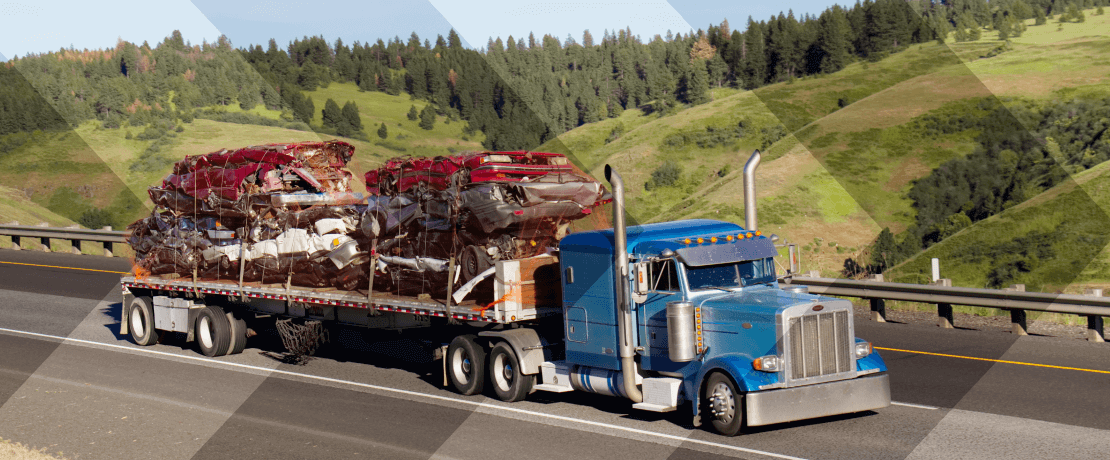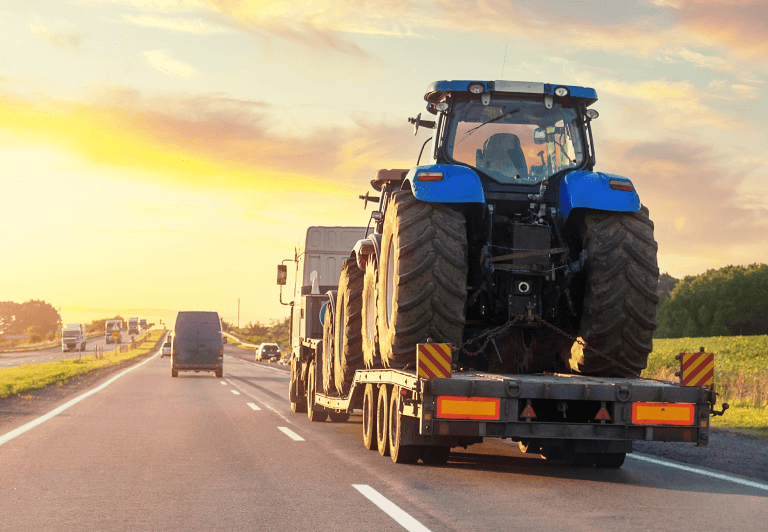Flatbed Shipping: Everything You Need to Know

If you’re in the trucking industry, you’ve probably heard of flatbed freight shipping. But exactly what is flatbed shipping? Flatbed truck shipping can be loosely defined as open transportation for oversized cargo. Rather than being enclosed in a trailer, the cargo is loaded and hauled on a flat platform with no walls. But for the carrier, “What is flatbed freight shipping?” is a complex question that goes beyond defining the words. Here’s what carriers need to know about this type of shipment.
What gets shipped on flatbed trucks?
Flatbed trucks can carry a wide variety of freight that is too big or awkward to transport in a regular dry van trailer. Common examples include, but are not limited to:
- Heavy machinery such as tractors and forklifts
- Lumber
- Long pipes
- Formed concrete items
- Wrapped, stackable products
- Shipping containers
- Cargo that needs to be loaded or unloaded with cranes or other specialized equipment
Keep in mind that flatbed trucks are not weatherproof. This is not the correct shipping option for products that need refrigeration or should not be exposed to the elements.
Flatbed shipping rates
Flatbed shipping rates are often higher than dry van rates. While the national average for dry van loads is $2.27 per mile, the national average for flatbed loads is $3.01 per mile. That difference can quickly add up. Of course, flatbed shipping is also more challenging and requires more skill than dry van shipping.
Benefits and challenges of flatbed shipping
Flatbed shipping is unlike any other type of shipping you might do. As you might expect, it has its own unique benefits and challenges for both carriers and shippers.
Benefits of flatbed shipping
Flatbed shipping offers several advantages over other types, which can be significant, depending on your circumstances.
Carriers
Flatbed shipping can be lucrative. It pays more than dry van shipping and is consistently in high demand. Drivers don’t need to wait for an empty dock since flatbeds can be loaded and unloaded from the top and both sides. This makes it easier to keep your trucks rolling, hauling loads, and making money.
Shippers
For shippers, flatbed shipping offers greater flexibility. With no walls or ceilings, flatbed trucks can easily haul oversized or oddly shaped freight. There are many different types of flatbed equipment, allowing shippers to choose the best type for a particular shipment.

Challenges of flatbed shipping
Of course, flatbed shipping also has its challenges. You’ll want to weigh the benefits versus downsides when deciding whether to add flatbed shipping to your services.
Carriers
Flatbed shipping requires highly skilled drivers. The cargo must be carefully loaded and secured. Drivers have to monitor the load frequently and avoid doing anything on the road that could shake it loose. Liability is a constant risk to be managed.
Shippers
Shippers generally pay a premium for flatbed shipping. They also assume the risk of cargo being exposed to the elements. In addition, shippers might need to hire specialized personnel and buy specific equipment to load and unload flatbed trucks.
Key steps in the flatbed shipping process
Flatbed shipping follows a specific, step-by-step process. To get the most out of this type of shipping, make sure you perform all of these steps.
Find
The first step is to find quality flatbed loads. You can pick up loads from brokers or shippers you already have an existing relationship with. But to keep your flatbed trucks consistently rolling, you’ll also need an ongoing source of new leads. A flatbed load board like the one from Truckstop can be an excellent solution. Our load board not only offers high-paying loads, but we also have the tools you need to find trustworthy shippers and brokers.
Load
When a driver picks up a flatbed shipment, it needs to be loaded onto the platform. Someone onsite usually handles this task with the aid of heavy equipment, such as forklifts and cranes. But it’s the driver’s responsibility to supervise the process and ensure the load is balanced, both top to bottom and over the axles. An unbalanced load is a recipe for disaster.
Secure
The next step is to secure the load according to Department of Transportation (USDOT) guidelines. Most of the time, drivers use thick nylon straps attached by a winch. But some cargo, such as machinery or steel pipes, requires chains. Your drivers should be very familiar with the DOT guidelines and good at deciding how best to secure a wide variety of cargo types.
While it’s impossible to fully weatherproof a flatbed trailer, drivers have a responsibility to provide a reasonable level of protection for the goods they haul. Each load must also be tarped. Weighing more than 80 pounds, these tarps are generally placed with a forklift and then anchored on the sides.
Drivers need to keep an eye on the load throughout their journey in case the straps need tightening or the tarp re-secured. Failing to monitor these things can result in dangerous and costly accidents.
Maneuver
Flatbed truckers need excellent driving skills. Flatbed platforms can be longer or wider than a traditional dry van trailer, and maneuverability is not the easiest. Use extra caution in heavy traffic and on curves, which can cause loads to shift and become unbalanced.

Safety tips for flatbed shippers
Following a few simple safety tips can help minimize the risks of flatbed shipping:
- Respect weight limits. Every truck has a gross vehicle weight rating (GVWR). This is the maximum that the entire combination can safely weigh, including the truck, the trailer, and the load, including fuel, passengers, and anything else. Never accept a load that will cause you to exceed the GVWR.
- Wear PPE during loading and unloading. Accidents can happen while loading or unloading, so always wear a hard hat, safety vest, and goggles. Gloves can also help protect the hands and improve grip.
- Never move an unsecured load. It might be tempting to move the truck a few feet to get it out of the way before securing the load, but this is risky. The driver is responsible for the load as soon as it’s on the truck, so take the time to make sure it’s secure.
- Check the load after one hour. Although loads can shift at any time, it’s most common in the first hour of driving. Pull over somewhere safe and inspect the load after one hour of drive time.
- Inspect your equipment daily. Even a minor truck problem could cause a severe accident when hauling a heavy flatbed load. Before and after each day’s driving, inspect the entire combination, paying close attention to the tires, wheels, and valve caps.
FAQs
Use a load board to find and book high-paying flatbed loads.
A carrier load board is the best way to find and book high-paying loads consistently. The Truckstop Load Board is packed with tools and features to help you not only find the right flatbed loads but also save time and money while negotiating the best rates. Get started today.

Find out how our platform gives you the visibility you need to get more done.
Get helpful content delivered to your inbox.
Schedule a demo.
Find out how our platform gives you the visibility you need to get more done.





